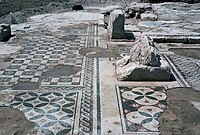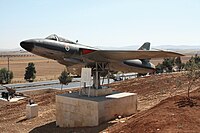Ar-Ramtha
Ar-Ramtha مدينة الرمثا | |
|---|---|
City | |
 The City Hall | |
| Coordinates: 32°33′32″N 36°0′53″E / 32.55889°N 36.01472°E | |
| Grid position | 245/218 |
| Country | Jordan |
| Province | Irbid Governorate |
| District | Ar-Ramtha District |
| Municipality established | 1927 |
| Government | |
| • Type | Municipality |
| • Mayor | Hussein Abu Ashshih |
| Elevation | 502 m (1,647 ft) |
| Population (2015)[1] | |
• Total | 155,693 |
| Time zone | GMT +2 |
| • Summer (DST) | +3 |
| Area code | +(962)2 |
| Website | http://www.ramthacity.gov.jo |
Ar-Ramtha (Arabic: الرَّمثا, romanized: ar-Ramṯā), colloquially transliterated as Ar-Romtha (Arabic: الرُّمثا, romanized: ar-Rumṯā), is a city situated in the far northwest of Jordan near the border with Syria. It covers 40 km2 on a plain 30 km northeast of the Jordan River and Irbid. In 2017, Ar-Ramtha had a population of approximately 164,211, making it the eleventh largest city in Jordan, and the second in Irbid Governorate, and the city has grown since then.[2] It is part of the Ar-Ramtha district of the Irbid Governorate.[3][4]
Etymology
The origin of the name Ar-Ramtha is debated. Some claim it is named after a local desert plant, al-ramath (Arabic: الرمثا). Many biblical archaeologists identify Ar-Ramtha with the ancient Israelite city of Ramoth-Gilead, Hebrew for "Heights of Gilead"; in that case, the present-day Arabic name might preserve the Biblical Hebrew one.[5][6]
During the Roman and Byzantine periods, Ar-Ramtha was known as Ramatha.
History
Prehistory
The stable climate in ar-Ramtha and its surrounding areas attracted many animals to live in neighborhood of ar-Ramtha, as well the simple conditions for managing a stable long life there attracted humans to make those regions their earliest choices to gather in groups of hunters and to live in rocky caves.
Ancient history
Artifacts and graves in the area show that ar-Ramtha has been inhabited at least since the Bronze Age, but the lack of study of the region gives us no exact information about when humans had selected the land for living.
Ar-Ramtha might be the location of the Israelite city of Ramoth-Gilead, a Levitical city and city of refuge east of the Jordan River, mentioned several times in the Hebrew Bible.[5][6] According to the Books of Kings, Ramoth-Gilead was the location of a battle between Kingdom of Israel and Aram Damascus. During the battle, King Ahab of Israel joined King Jehoshaphat of Judah to fights the Aramaeans but was hit by an arrow and died from his wounds. Later on, it was also the location of a battle where Ahaziah of Israel and Jehoram of Judah fought against Hazael, king of Aram Damascus, and Jehoram was wounded. In this city, Jehu, the son of Jehoshaphat, was anointed by Elisha.
Classical Era
The Roman Empire utilized ar-Ramtha as a remote hub to cross-link their colonies. The ruins of buildings and ancient Roman antiquities have been discovered at different parts of ar-Ramtha. During the Islamic expansion, ar-Ramtha, which was in the Hauran territory, was a port for Muslim scholars crossing between Syria and the Hejaz. Historically and sociologically, the city is the twin to Daraa city in Syria, which is located on just the other side of the border.[citation needed]

Ottoman era
In 1596 it appeared in the Ottoman tax registers under the name of Ramta, being part of the nahiya of Butayna in the Qadaa Hauran. It had an entirely Muslim population consisting of 16 households and 3 bachelors. They paid a fixed tax-rate of 40% on agricultural products, including wheat, barley, summer crops, goats and bee-hives; a total of 2,740 akçe. Half of this was waqf income.[7]
Modern era
The Jordanian census of 1961 found 10,791 inhabitants in Ramtha.[8] The city has grown to a population of 263,680 in 2021. Due to its location, Ramtha played a significant role in helping refugees fleeing the Syrian Civil War to Jordan.

Geography
North west of ar-Ramtha is the second largest source of shale oil in Jordan,[9] which if it is used in producing oil, can enhance economics in Jordan significantly.
Climate
Ar-Ramtha experiences a Mediterranean climate (Csa~Dsa). The summer is hot and long (four months in average), but it has cool nights. Temperatures range in summer from 27 °C (81 °F) – 33 °C (91 °F). Spring and fall temperatures are ideal for a human's body, they range from 17 °C (63 °F) – 23 °C (73 °F). The winter sees nighttime temperatures sometimes below0 °C (32 °F), with snowfall once or twice a year. The yearly average number of days with rain is 77. The lowest temperature ever recorded in Romtha was −18 °C in the blizzard of 1992.
| Climate data for Romtha/Irbid (1982–2008) | |||||||||||||
|---|---|---|---|---|---|---|---|---|---|---|---|---|---|
| Month | Jan | Feb | Mar | Apr | May | Jun | Jul | Aug | Sep | Oct | Nov | Dec | Year |
| Record high °C (°F) | 12.3 (54.1) |
13.8 (56.8) |
23.2 (73.8) |
25.6 (78.1) |
25.7 (78.3) |
30.4 (86.7) |
33.4 (92.1) |
36.1 (97.0) |
32.5 (90.5) |
26.9 (80.4) |
18.2 (64.8) |
12.7 (54.9) |
36.1 (97.0) |
| Mean daily maximum °C (°F) | 3.0 (37.4) |
5.9 (42.6) |
12.0 (53.6) |
18.7 (65.7) |
23.6 (74.5) |
25.5 (77.9) |
27.7 (81.9) |
32.3 (90.1) |
26.1 (79.0) |
20.5 (68.9) |
13.6 (56.5) |
7.2 (45.0) |
18.0 (64.4) |
| Mean daily minimum °C (°F) | −4.9 (23.2) |
−2.5 (27.5) |
2.3 (36.1) |
8.8 (47.8) |
9.4 (48.9) |
14.6 (58.3) |
19.7 (67.5) |
18.4 (65.1) |
14.8 (58.6) |
8.5 (47.3) |
5.3 (41.5) |
0.5 (32.9) |
7.9 (46.2) |
| Record low °C (°F) | −20.7 (−5.3) |
−4.6 (23.7) |
0.2 (32.4) |
3.6 (38.5) |
5.5 (41.9) |
8.0 (46.4) |
10.2 (50.4) |
14.8 (58.6) |
9.1 (48.4) |
2.4 (36.3) |
−7.5 (18.5) |
−13.7 (7.3) |
−20.7 (−5.3) |
| Average rainfall mm (inches) | 163.0 (6.42) |
230.7 (9.08) |
86.0 (3.39) |
55.3 (2.18) |
27.1 (1.07) |
6.1 (0.24) |
0.0 (0.0) |
0.0 (0.0) |
12.1 (0.48) |
46.3 (1.82) |
83.5 (3.29) |
114.0 (4.49) |
824.1 (32.46) |
| Source: [10] | |||||||||||||
Economy
Ar-Ramtha's economy relies on commerce and import and export trading. The Al Hassan industrial estate houses several outsourcing companies supported by foreign shareholders with most of the products sold to American and European markets.[citation needed]
Before the outbreak of war in Syria in 2011, Ramtha's economy depended in large part on imports, both licit and illicit, with Syria. These goods were imported by so-called "bahhara" (sailors), Jordanian drivers permitted to enter Syria. Since 2011, this trade has dried up, causing increases in unemployment and poverty in Ramtha.[11]
Culture
The city is famous for the inherited ritual-poetries recited in wedding ceremonies and public affairs. Dabke is an Arab folk dance native to Ar-Ramtha. Prominent artists from Ar-Ramtha include Hussein Al-Salman, Lil ZeeJo - (Husam El-Zubi), Malik Allaham, Najem Al-Salman, Suliman Athamneh, Hala Athamneh, and Mitaab Al-Saggar.[citation needed]
Sport
This city has two sports clubs, Al-Ramtha SC, a football club which is also a member of the premium Jordan League, and Ittihad Al-Ramtha, another football club which is a member in the first division in Jordanian Football League.
Education

The city is home to the Jordan University of Science and Technology, which includes a large University hospital, KAUH that provides medical treatment in the region, and offers chances to medical students in the university to intern and learn during their study years.
See also
References
- ^ "The General Census – 2015" (PDF). Department of Population Statistics.
- ^ "Population of Jordan 2017" (PDF). Archived from the original (PDF) on 25 August 2018. Retrieved 1 November 2018.
- ^ "Jordan: Administrative Division, Governorates and Districts". citypopulation.de. Retrieved 25 December 2016.
- ^ "Atlas of ELECTORAL DISTRICTS" (PDF). UNDP. Retrieved 30 January 2019.
- ^ a b Knauf, E. A., 2001: The Mists of Ramthalon, or, How Ramoth-Gilead disappeared from the Archaeological Record. BN 110, 33–36.
- ^ a b Lapp, P., 1968: Tell er-Rumeith. RB 75, 98–105.
- ^ Hütteroth and Abdulfattah, 1977, p. 214
- ^ Government of Jordan, Department of Statistics, 1964, p. 13
- ^ The World Factbook
- ^ "Jordan Meteorological Department". Jordan Meteorological Department. Retrieved 12 February 2009.
- ^ Tokmajyan, Armenak. "Thwarting Jordan's Bahhara Trade With Syria Risks Social Unrest in Ramtha". Carnegie Middle East Center. Retrieved 20 January 2023.
Bibliography
- Government of Jordan, Department of Statistics (1964). First Census of Population and Housing. Volume I: Final Tables; General Characteristics of the Population (PDF).
- Hütteroth, W.-D.; Abdulfattah, K. (1977). Historical Geography of Palestine, Transjordan and Southern Syria in the Late 16th Century. Erlanger Geographische Arbeiten, Sonderband 5. Erlangen, Germany: Vorstand der Fränkischen Geographischen Gesellschaft. ISBN 3-920405-41-2.


